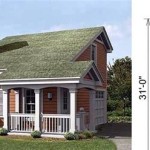How Do I Find the Original Floor Plan of My House For Free in Oregon?
Locating the original floor plan of a house can be an invaluable asset for homeowners in Oregon. Whether planning renovations, verifying property boundaries, or simply satisfying curiosity about a home's history, having access to this document can streamline projects and provide critical information. While obtaining these plans can sometimes involve a fee, there are several avenues to explore for free in Oregon. This article outlines the key resources and strategies for uncovering original house plans without incurring any costs.
The process of locating a floor plan can be influenced by factors such as the age of the house, when it was built, the jurisdiction where it is located, and whether previous owners retained copies. Older homes, particularly those built before widespread digital record-keeping, may present more of a challenge. Understanding these factors is the first step in a successful search.
1. Local City and County Government Resources
The primary and often most fruitful starting point is the local city or county government where the house is located. Building departments and planning departments are the most likely repositories for original house plans. These departments are responsible for permitting, inspections, and maintaining records related to construction projects. These records often include submitted floor plans as part of the permit application process.
To begin, identify the specific city and county in which the house is situated. This information is crucial, as record-keeping practices and online accessibility can vary significantly between jurisdictions. Once the relevant city and county are identified, locate their respective websites. Most local governments in Oregon have a digital presence, offering access to various services and information.
Navigate to the building department or planning department section of the website. Look for information on permit records, building plans, or property information. Many jurisdictions offer online databases or search tools that allow users to search for building permits by address, owner name, or permit number. If such a tool is available, utilize it to search for any permits associated with the house. If the search yields results, review the permit details to determine if floor plans were submitted as part of the application.
If online access is limited or non-existent, contact the building or planning department directly. Most departments have contact information, including phone numbers and email addresses, listed on their website. When contacting the department, be prepared to provide the property address, and any other relevant information, such as the year the house was built. Inquire about the availability of building plans and the process for accessing them. It's important to note that some jurisdictions may require a formal request for records, which may involve filling out a form and providing identification.
In some cases, accessing building plans may require an in-person visit to the department's office. While there, request to view the property's records. Building department staff can usually guide you to the relevant files and assist with your search. Be prepared to take notes, photographs, or make copies of any floor plans you find. While the viewing may be free, copying services might incur a nominal fee, depending on the jurisdiction's policies.
It's important to be aware that not all jurisdictions retain building plans indefinitely. Older records may have been archived or destroyed due to space limitations or changes in record-keeping practices. However, it's always worth checking, as even if the original plans are not available, the building department may have other documents, such as as-built drawings or inspection reports, which can provide valuable information about the house's layout.
For example, consider a house located in Portland, Oregon. The homeowner would need to access the City of Portland's Bureau of Development Services (BDS) website. The BDS website provides access to permit records and allows users to search for building permits by address or permit number. If the homeowner is unable to find the floor plan online, they can contact the BDS directly to inquire about accessing the records in person.
2. County Assessor's Office Records and Tax Maps
Another valuable resource is the county assessor's office. While the assessor's primary responsibility is to determine property values for tax purposes, they often maintain records that include information about building dimensions and layouts. These records may not be as detailed as original floor plans, but they can provide a general overview of the house's structure.
The county assessor's office typically has a website where property records are accessible. Use the website to search for the property by address or owner name. The property record may include a sketch of the house, indicating the dimensions of each room and the overall layout. This information can be helpful in understanding the spatial relationships within the house.
In addition to property records, the county assessor's office may also have tax maps or plat maps. These maps show the boundaries of individual properties and may include information about building setbacks and easements. While tax maps may not show the interior layout of the house, they can provide valuable context about the property's overall configuration.
Accessing records from the county assessor's office is generally free of charge, although some jurisdictions may charge a fee for printing or copying documents. As with building departments, it's advisable to contact the assessor's office directly to inquire about the availability of records and the process for accessing them. An in-person visit may be required to view certain documents.
For instance, a homeowner in Deschutes County, Oregon, can access property information through the Deschutes County Assessor's Office website. Here, they can search for property records by address or map number and potentially find sketches or diagrams of their house.
3. Historical Societies and Local Libraries
For older homes, especially those with historical significance, local historical societies and libraries can be valuable resources. These institutions often maintain archives of historical documents, photographs, and maps related to the community's past. While they may not have the original floor plan of every house, they may have documents that can provide clues about the house's original design.
Contact local historical societies to inquire about their holdings related to the house or neighborhood. They may have photographs of the house from different eras, which can provide insights into its architectural style and original features. They may also have maps or plat books that show the house's location within the community.
Local libraries can also be a valuable resource. Libraries often have collections of local history materials, including books, pamphlets, and newspaper articles. These materials may contain information about the house's history, including its original owners, builders, and architectural features. Some libraries also have online databases of historical photographs and documents.
Historical societies and libraries are generally non-profit organizations, and access to their collections is usually free. However, they may have limited hours of operation, so it's advisable to check their schedules before visiting. Be prepared to spend time browsing through their collections and asking questions of the staff.
Consider a homeowner living in a historic district in Salem, Oregon. They could contact the Marion County Historical Society or visit the Salem Public Library to research the history of their house. These institutions may have photographs, maps, or other documents that provide insights into the house's original design.
4. Checking With Previous Owners, Neighbors, and Builders
While not a guaranteed method, reaching out to previous owners, long-time neighbors, or even the original builders (or their descendants) may yield unexpected results. Previous owners might have retained copies of the floor plans from when they purchased the house, or they may recall details about renovations or additions that could help reconstruct the original layout.
Neighbors who have lived in the area for a long time might also have valuable insights into the history of the house. They may have seen old photographs or have heard stories about the house from previous residents. Their collective memory can sometimes piece together details that are not available in official records.
If the house was built by a local construction company that is still in business, contact them to inquire about their records. They may have retained copies of the floor plans or specifications for the house. Even if the original company is no longer in business, there may be descendants or successors who have inherited their records.
Methods for contacting these individuals include online searches, social media platforms, or even contacting local real estate agents who may have knowledge of the neighborhood's history. When reaching out, be polite and respectful of their time. Explain your purpose and provide as much information as possible about the house.
This method relies on luck and networking, but it can sometimes lead to surprising discoveries.
It's important to remember that finding the original floor plan of a house for free can be a time-consuming process that requires persistence and patience. Not all attempts will be successful, and it may be necessary to explore multiple resources before finding what you're looking for. However, by following the steps outlined in this article, homeowners in Oregon can increase their chances of uncovering this valuable document without incurring any costs.

Building Permit Plans Portland Gov

House Plans Floor Blueprints

Building Permit Plans Portland Gov

How To Obtain A Site Plan Of My Property Cedreo

How To Obtain A Site Plan Of My Property Cedreo

House And Building History

Building Permit Plans Portland Gov
Pre Approved Accessory Dwelling Units City Of Bend

Home Floor Plans House Layouts Blueprints

House Plans Floor Blueprints
Related Posts








